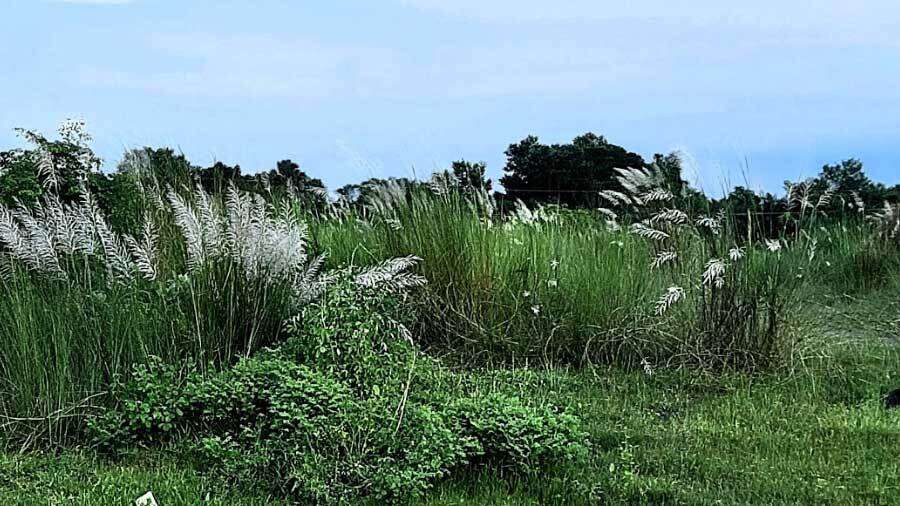Now that we are all staying home to stay safe, it's time to stock up on travel plans.
In the tiny village of Massanjore, in Dumka district of Jharkhand, lies a huge dam — a popular picnic spot with locals and Bengali tourists alike. The mention of Dumka brings to mind the long association between the ‘Calcutta bhodroloks’ and the sleepy towns in the Santhal Pargana — Jashidih, Giridih, Jhanjhah, Deoghar, Madhupur, Jamtara. These towns, with their unpolluted air and mineral-rich water considered to have miraculous digestive properties, were popular destinations for annual vacations of affluent Bengali families. One remembers reading and hearing anecdotes about ‘Danchy Babus’ (gullible city-dwellers who would find everything ‘damn cheap’ in the countryside) and their Santhal Pargana exploits. It was with such context that we headed off from Santiniketan one morning in search of Massanjore-on-Mayurakshi. And we were not disappointed!

Kashphul-covered river banks past Santiniketan Chaiti Mitra
The two-and-a-half-hour drive on the Bolpur-Siuri road became enjoyable once we turned left from the congested town of Siuri. The road, patchy at places, was otherwise in good condition, in spite of an unusually heavy and prolonged monsoon this year. As we drove on, the colour palette changed from the fluorescent greens of the paddy fields and the fluffy whites of the ‘kashphul’-covered river banks, to the dark green of the Sal-Segun-Mahua forests and red laterite roads running through them. The spectacular blue sky added to the canvas, as did scattered thickets of bright yellow and orange wildflower bushes. About an hour-and-a-half into the drive, the low hills of the Chhotanagpur Plateau were visible on the horizon.
The drive becomes enjoyable after leaving the congested town of Siuri Chaiti Mitra
In addition to the popular ‘morabba’ (pieces of fruit marinated or boiled in sugar syrup) shops in Siuri, we stopped at small roadside dhabas and even smaller tea shacks on the way. We also halted at the smaller Tilpara Barrage on the Mayurakshi river, some 32 km away from Massanjore.
The tranquillity is all too evident Chaiti Mitra
On reaching the dam, tourists can check in at any of the properties present for rest and a sumptuous lunch. Or, as we did, simply walk about enjoying the tranquil lake reflecting the blue sky, the forests lining the lake and the spectacular sunset. The small roadside eateries provide the tastiest snacks and lunch — fish fries and curries with locally caught fish, country chicken and an amazing choice of vegetable fritters and curries.
The reservoir or lake is about 67 sq. km in size Chaiti Mitra
Post lunch, as we waited for the much-talked-about sunset, we drove leisurely through the forest towards Dumka and reached a busy junction, Pattabari More, where stacks of fresh jalebis, samosas and namkeens awaited us. A breath-taking sunset ended a thoroughly satisfying day and made us yearn for a return visit — to spend a moonlit night by the lake, atop the hillocks.
Stacks of fresh jalebis greet visitors at Pattabari More Chaiti Mitra
Quick facts:
- Massanjore is 270 km from Kolkata, 70 km from Bolpur and 32 km from Dumka. Buses plying between Siuri and Dumka pass through Massanjore.
- The Massanjore Dam, built in the 1950s with Canadian aid, is also known locally as Canada Dam or Pearson Dam, after the then-External Affairs Minister of Canada, Lester B Pearson, who inaugurated it.
- This 2,100-feet-long and 155-feet-high dam across the Mayurakshi is in Dumka district, Jharkhand, but the benefits of irrigation and hydroelectric projects are enjoyed by West Bengal.
- The reservoir or lake is about 67 sq. km, with boating facilities during certain months.
- A very popular picnic spot, it is extremely crowded during winter weekends. It is best to visit on weekdays, or during September-November and February-March.
Places to stay
- Mayurakshi Bhavan, offering the best view of the lake, is under the Irrigation Department, Govt. of West Bengal, and can be booked from Jal Sampad Bhavan, Salt Lake, Kolkata.
- For the Jharkhand Govt’s Irrigation Bungalow, which also offers a spectacular view of the lake, write to the Superintendent Engineer, Irrigation Dept, Dumka 814101
- Youth Hostel, affordable rooms and dormitories, can be booked from the Yuva Kalyan Office, 32/1, BBD Bag (South), Kolkata
Chaiti Mitra is Associate Professor in the Department of English, Ramakrishna Sarada Mission Vivekananda Vidyabhavan, Kolkata, and Guest Faculty at the Post Graduate Department of English, West Bengal State University. She has published several articles on narratives of trauma and resistance, and has recently published her first book, 'Boudoir to Bibighar: The Memsahibs and the 1857 Mutiny Narratives'. In her spare time, she is an amateur translator, avid traveler and theatre enthusiast.

